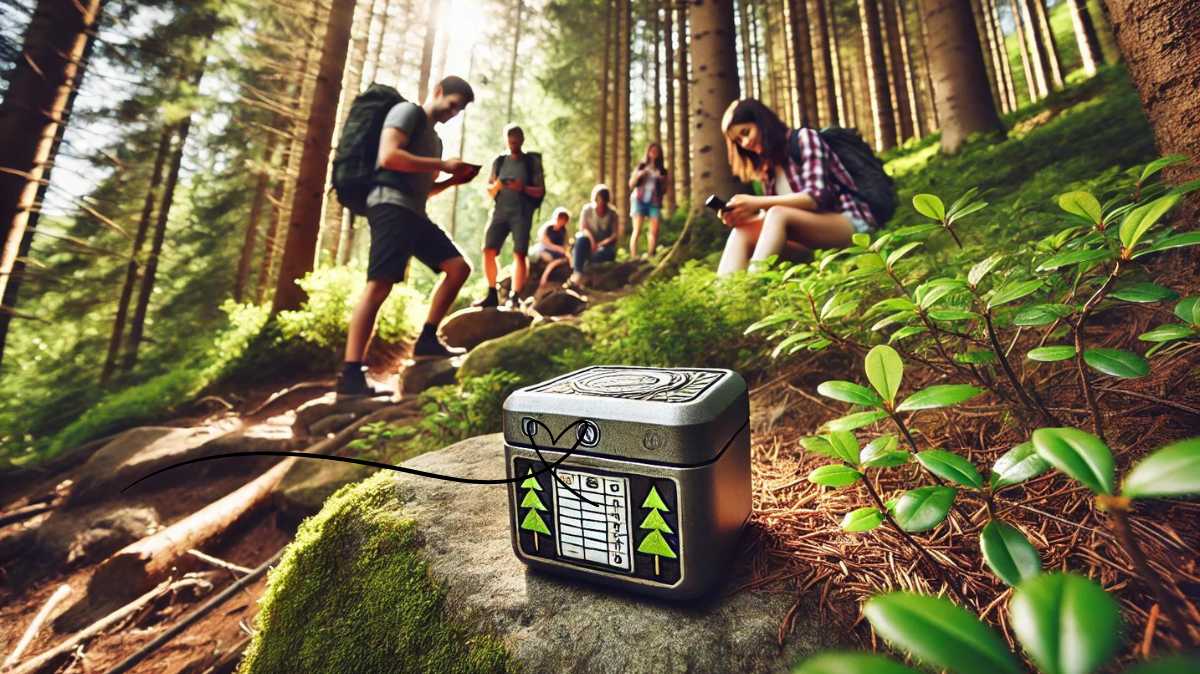Outdoor activities are merging with technology in fascinating ways. One such adventure is geocaching, a worldwide treasure hunt that combines exploration, problem-solving, and community spirit. But what is a geocache, and how does this engaging activity work? Whether you’re a curious beginner or an experienced geocacher, this comprehensive guide will uncover the details behind the modern-day treasure hunt.
Table of Contents
What is a Geocache?
At its core, a geocache is a hidden container placed by geocachers in various outdoor locations worldwide. These caches contain a logbook for hunters to sign, and sometimes small trinkets or items for trading. Geocachers use GPS devices or smartphones to find these hidden treasures by following coordinates shared on geocaching websites or apps.
Geocaching blends adventure and technology, offering participants the opportunity to explore hidden spots, often in places they might never have thought to look. The simplicity of it — seeking and finding — gives it mass appeal. But for those who want more, geocaching can provide a complex and richly rewarding experience, with puzzles, multi-stage hunts, and creative hides.
How Geocaching Began: A Brief History
The origins of geocaching date back to May 2000, when improvements in GPS technology made pinpoint accuracy possible for everyday users. On May 3, 2000, Dave Ulmer, a computer consultant, placed the first cache, then called a “stash,” near Beaver Creek in Oregon, USA. He posted the coordinates online and invited others to find it. It didn’t take long before enthusiasts from all over the world joined in, and geocaching as we know it today was born.
Initially known as “GPS Stash Hunt,” the name evolved into geocaching, combining “geo” (earth) and “cache” (a hidden or stored item). Since its inception, the game has grown into a global phenomenon, with over 3 million active caches in more than 190 countries.
How Geocaching Works: Key Components
1. The Cache:
A geocache is a physical container hidden at a specific location. These containers can vary in size and shape, ranging from tiny magnetic boxes to larger, waterproof containers like Tupperware. Inside, you’ll find a logbook for finders to sign, and in many cases, small tradeable items, known as “swag.”
2. GPS Coordinates:
To find a geocache, participants are provided with its GPS coordinates. These coordinates are shared via websites such as Geocaching.com, where users can search for caches based on location, difficulty, or type. Each set of coordinates leads you close to the hidden geocache, but often, it’s up to you to complete the search.
3. The Logbook:
The logbook is an essential part of any cache. When a player finds a geocache, they sign the logbook with their geocaching username and the date of their discovery. Signing the log signifies that they have completed the challenge and found the treasure.
4. Geocaching Tools:
Most geocachers use a GPS-enabled smartphone or a dedicated GPS device to track coordinates. Additionally, some caches might require tools such as a UV flashlight for puzzles or tweezers for retrieving logbooks from tiny containers.
Different Types of Geocaches
Geocaching isn’t limited to simple hide-and-seek activities. There are multiple types of caches, each offering a unique challenge.
1. Traditional Geocache:
This is the most basic type of geocache — a single container placed at the coordinates listed. The container holds a logbook, and often small tradeable items.
2. Multi-Cache:
A multi-cache involves two or more locations. At each stage, geocachers will need to solve clues or find additional coordinates that lead them to the final location. This type of cache is ideal for those who enjoy problem-solving or exploring larger areas.
3. Mystery or Puzzle Caches:
In order to find a mystery cache, geocachers must solve a puzzle before obtaining the final coordinates. The puzzles can vary in difficulty, making these caches particularly exciting for those who love brain teasers.
4. EarthCache:
Unlike traditional caches, EarthCaches don’t contain physical containers. Instead, these focus on teaching players about geological phenomena. To log an EarthCache, players must answer questions based on their visit to the location.
5. Event Cache:
Event caches are organized gatherings where geocachers come together to socialize and share their experiences. These events often occur around a specific theme, such as a “Cache In, Trash Out” (CITO) event, which promotes environmental stewardship by combining geocaching with a community cleanup.
The Geocaching Community: A Global Adventure
Geocaching has fostered a tight-knit global community of adventurers. With millions of active geocachers worldwide, players often leave notes or hints for each other, providing a sense of camaraderie. Many geocachers enjoy sharing their adventures on social media or participating in forums where they exchange tips and stories.
Popular platforms like Geocaching.com and various social media groups allow people to connect, exchange experiences, and even collaborate on solving particularly difficult caches. These platforms also host leaderboards, adding a competitive edge for those seeking to climb the ranks in the geocaching world.
Why People Geocache: The Appeal of the Hunt
1. Exploration and Discovery:
One of the key draws of geocaching is the thrill of discovery. Many caches are hidden in locations off the beaten path, introducing hunters to new areas, parks, or historic sites they may not have otherwise visited. Geocaching is an exciting way to combine outdoor activities like hiking, biking, or even scuba diving with treasure hunting.
2. Challenges and Puzzles:
For those who enjoy problem-solving, the different types of caches (especially mystery or multi-caches) provide intricate puzzles to solve. Some caches can involve multi-step tasks, cryptic clues, or even deciphering codes before finding the actual treasure.
3. Social and Competitive Aspects:
The geocaching community is vast, and the social aspect of the game allows players to connect globally. Whether it’s attending a geocaching event or competing for the fastest “find,” the game appeals to both casual and competitive players alike.
4. Environmental Stewardship:
Through events like Cache In, Trash Out (CITO), geocachers give back to the environment by combining their love of the game with cleaning up local areas. This initiative has made geocaching more than just a game; it’s also a movement that promotes environmental responsibility.
Safety Tips for Geocaching
While geocaching is an enjoyable and rewarding activity, it’s essential to follow safety guidelines, especially when venturing into remote or unfamiliar areas.
- Stay Aware of Your Surroundings: Always be mindful of where you’re caching, especially in urban environments or secluded areas.
- Bring Supplies: Water, snacks, a first-aid kit, and appropriate clothing are essentials for outdoor adventures.
- Cache with a Buddy: While many caches can be found solo, it’s always safer to explore with someone, particularly in more remote locations.
- Check Cache Difficulty: Always assess the terrain and difficulty ratings before attempting a new geocache. Some caches are more physically demanding or located in challenging environments.
How to Start Geocaching: A Beginner’s Guide
Starting geocaching is simple. Here’s how to get started:
- Create an Account: Sign up on a geocaching website like Geocaching.com to access the database of caches.
- Download the App: Install the official geocaching app or any GPS app that supports geocache coordinates.
- Search for Geocaches: Using your location, search for caches near you. You can filter by difficulty, type, or size.
- Get Equipped: Grab a GPS-enabled device or smartphone, and pack essentials like water and a pen (to sign the logbook).
- Follow the Coordinates: Head to the cache’s listed coordinates, search carefully, and when you find it, sign the logbook.
- Log Your Find Online: After finding the cache, be sure to log your discovery online. This helps cache owners and other players track the activity.
FAQs About Geocaching
1. What should I do if I can’t find a geocache? If you’re having trouble finding a cache, double-check the coordinates and read any hints provided. If still unsuccessful, log a “Did Not Find” (DNF) on the website to notify the cache owner.
2. Are there any rules I need to follow when geocaching? Yes, geocaching has a few core rules: respect the environment, avoid damaging property, and always log your finds.
3. What’s in a geocache? Most geocaches contain a logbook and, sometimes, small tradeable items or “swag.” Remember to trade items fairly if you decide to take something.
4. Do I need special equipment to geocache? A GPS-enabled smartphone is typically enough. However, additional tools like a UV light or tweezers may be useful for specific caches.
5. Is geocaching safe for children? Yes, geocaching can be a fun family activity. There are many kid-friendly caches with easy-to-access locations and enjoyable treasures.
6. How do I hide my own geocache? After finding several caches, many players choose to hide their own. This involves selecting a good location, preparing a container, and registering the cache with the proper geocaching website.
Conclusion
Geocaching offers a blend of adventure, education, and outdoor exploration that continues to capture the imaginations of millions worldwide. Whether you’re hunting for a hidden cache in your local park or exploring unknown territories, the thrill of discovery keeps geocachers returning for more.
Author

An aspiring business leader, I am working towards my dream of graduating from Stanford University with a degree in Business Management. Passionate about sharing knowledge, I strive to empower others through education and collaborative learning.
View all posts


